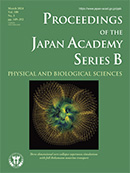
- 4 号 p. 253-
- 3 号 p. 149-
- 2 号 p. 101-
- 1 号 p. 1-
- |<
- <
- 1
- >
- >|
-
Tetsuo IRIFUNE2024 年 100 巻 3 号 p. 149-164
発行日: 2024/03/11
公開日: 2024/03/11
[早期公開] 公開日: 2024/02/03ジャーナル オープンアクセス HTMLSince the large-volume press with a double-stage multianvil system was created by the late Professor Naoto Kawai, this apparatus (Kawai-type multianvil apparatus or KMA) has been developed for higher-pressure generation, in situ X-ray and neutron observations, deformation experiments, measurements of physical properties, synthesis of high-pressure phases, etc., utilizing its large sample volume and capacity in stable and homogeneous high temperature generation compared to those of competitive diamond anvil cells. These advancements in KMA technology have been made primarily by Japanese scientists and engineers, which yielded a wealth of new experimental data on phase transitions, melting relations, and physical characteristics of minerals and rocks, leading to significant constraints on the structures, chemical compositions, and dynamics of the deep Earth. KMA technology has also been used for synthesis of novel functional materials such as nano-polycrystalline diamond and transparent nano-ceramics, opening a new research field of ultrahigh-pressure materials science.
抄録全体を表示PDF形式でダウンロード (9401K) HTML形式で全画面表示
-
Yuichiro NAGAME, Tetsuya K. SATO2024 年 100 巻 3 号 p. 165-189
発行日: 2024/03/11
公開日: 2024/03/11
ジャーナル オープンアクセス HTMLThe chemical characterization of the heaviest elements at the farthest reach of the periodic table (PT) and the classification of these elements in the PT are undoubtedly crucial and challenging subjects in chemical and physical sciences. The elucidation of the influence of relativistic effects on their outermost electronic configuration is also a critical and fascinating aspect. However, the heaviest elements with atomic numbers Z ≳ 100 must be produced at accelerators using nuclear reactions of heavy ions and target materials. Therefore, production rates for these elements are low, and their half-lives are as short as a few seconds to a few minutes; they are usually available in a quantity of only a few atoms at a time. Here, we review some highlighted studies on heavy actinide and light transactinide chemical characterization performed at the Japan Atomic Energy Agency tandem accelerator facility. We discuss briefly the prospects for future studies of the heaviest elements.
抄録全体を表示PDF形式でダウンロード (2828K) HTML形式で全画面表示 -
Shoichi YAMADA, Hiroki NAGAKURA, Ryuichiro AKAHO, Akira HARADA, Shun F ...2024 年 100 巻 3 号 p. 190-233
発行日: 2024/03/11
公開日: 2024/03/11
ジャーナル オープンアクセス HTMLThe current understanding of the mechanism of core-collapse supernovae (CCSNe), one of the most energetic events in the universe associated with the death of massive stars and the main formation channel of compact objects such as neutron stars and black holes, is reviewed for broad readers from different disciplines of science who may not be familiar with the object. Therefore, we emphasize the physical aspects than the results of individual model simulations, although large-scale high-fidelity simulations have played the most important roles in the progress we have witnessed in the past few decades. It is now believed that neutrinos are the most important agent in producing the commonest type of CCSNe. The so-called neutrino-heating mechanism will be the focus of this review and its crucial ingredients in micro- and macrophysics and in numerics will be explained one by one. We will also try to elucidate the remaining issues.
抄録全体を表示PDF形式でダウンロード (8477K) HTML形式で全画面表示 -
Daisuke IWAI2024 年 100 巻 3 号 p. 234-251
発行日: 2024/03/11
公開日: 2024/03/11
ジャーナル オープンアクセス HTMLThis study summarizes current trends and future directions in projection mapping technologies. Projection mapping seamlessly merges the virtual and real worlds through projected imagery onto physical surfaces, creating an augmented reality environment. Beyond traditional applications in advertising, art, and entertainment, various fields, including medical surgery, product design, and telecommunications, have embraced projection mapping. This study categorizes recent techniques that address technical challenges in accurately replicating desired appearances on physical surfaces through projected imagery into four groups: geometric registration, radiometric compensation, defocus compensation, and shadow removal. It subsequently introduces unconventional projectors developed to resolve specific technical issues and discusses two approaches for overcoming the inherent limitations of projector hardware, such as the inability to display images floating above physical surfaces. Finally, this study concludes the discussion with possible future directions for projection mapping technologies.
抄録全体を表示PDF形式でダウンロード (3075K) HTML形式で全画面表示
-
Hiroyoshi NISHIKAWA2024 年 100 巻 3 号 p. 252
発行日: 2024/03/11
公開日: 2024/03/11
ジャーナル オープンアクセス HTMLPDF形式でダウンロード (767K) HTML形式で全画面表示
- |<
- <
- 1
- >
- >|